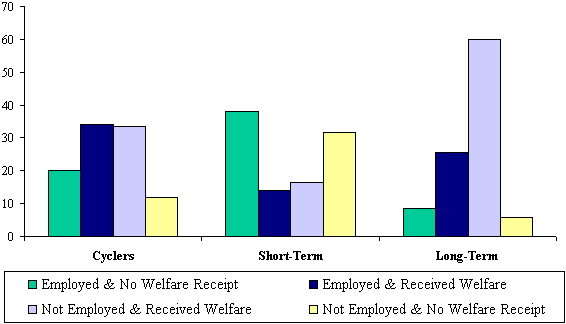Background
Since the passage of the Personal Responsibility and Work Opportunity Reconciliation Act of 1996 (PRWORA), there has been a growing literature on welfare exits and recidivism. Less is known, however, about the families that “cycle” — that is, return to welfare repeatedly. The goals of this report were to understand the incidence of cycling and the types of families who cycle on and off the rolls, and, if possible, to shed light onto why they repeatedly return to assistance.
Under contract with the Office of the Assistant Secretary for Planning and Evaluation (ASPE), MDRC analyzed the experiences of welfare cyclers using data from five MDRC studies of welfare reform conducted during the mid- to late-1990s. Three of these studies were experimental evaluations of welfare reform initiatives — Connecticut Jobs First, Florida Family Transition Program (FTP), and Vermont Work Restructuring Project (WRP). Two were non-experimental studies of the effects of welfare reform in large urban areas: Cleveland (Cuyahoga County) and Philadelphia Urban Change.
Cyclers were defined as those who received welfare benefits during three or more discrete spells during a four-year observation period. MDRC compared welfare, employment, and other outcomes for cyclers to those of two other groups within the welfare caseload: short-term recipients and long-term recipients. A short-term recipient was defined as someone who had 1 or 2 spells and a total of up to 24 months of welfare receipt during the 4-year (48-month) observation period. Long-term recipients were defined as sample members with 1 or 2 spells and a total of 25 to 48 months of welfare receipt during the observation period.
Findings
Overall, cyclers constituted a relatively small portion of the welfare caseload. Only 9 percent of recipients became welfare cyclers during the four-year observation period. About 47 percent of sample members became short-term recipients and 45 percent became long-term recipients. Rates of cycling ranged from 3.8 percent of sample members (in Philadelphia) to 13.7 percent (in Florida FTP).
Cyclers generally fared better than long-term recipients, but not as well as short-term recipients. For example, 28 percent of cyclers worked during at least three-fourths of the quarters of observation, compared to 35 percent of short-term recipients and only 12 percent of long-term recipients.
Cyclers demonstrated a greater propensity to combine welfare and work than both short- and long-term recipients. For cyclers, quarters with both earnings and welfare receipt accounted for just over one-third of all quarters in the period, compared to only 26 percent and 14 percent for short-term and long-term recipients respectively, as shown in Table 1.
Table 1.
Percentage of Quarters Working and Receiving Welfare During Years 1-4 After Sample Intake

Source: MDRC Evaluation data from Connecticut Jobs First,
Florida Family Transition Program (FTP) and Vermont Work Restructuring Project (WRP), and
MDRC Urban Change data from Cleveland and Philadelphia.
Note: Short-term recipients had 1-2 welfare spells for a total of up to 24 months of receipt,
long-term recipients had 1-2 welfare spells for a total of 25 to 48 months, and
cyclers had a total of 3 welfare spells during the 4-year period.
The report also found that the incidence of cycling increased during the years following PRWORA. In Cleveland and Philadelphia, the sites with the longest sample intake periods, rates of cycling were about 3 percentage points higher among welfare recipients who entered the research sample following passage of PRWORA, when compared with welfare recipients who entered the research sample previous to its passage. Furthermore, cyclers constituted a larger portion of the welfare caseload by end of the 1990s than earlier in the decade.
